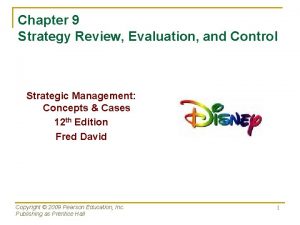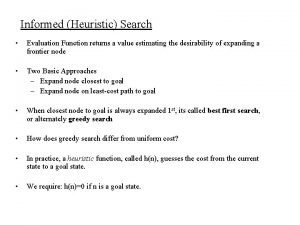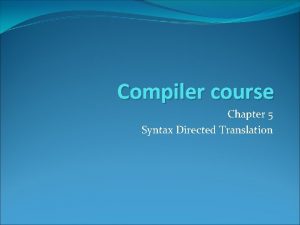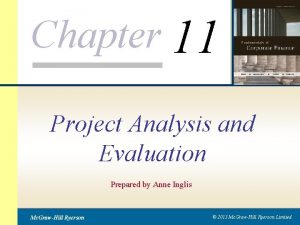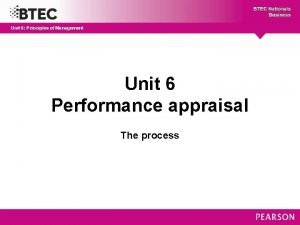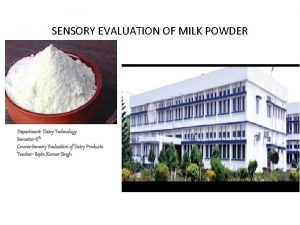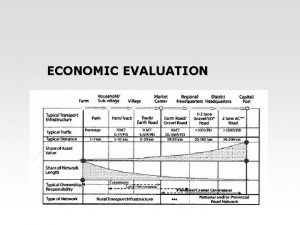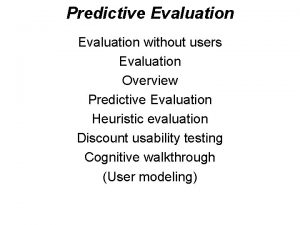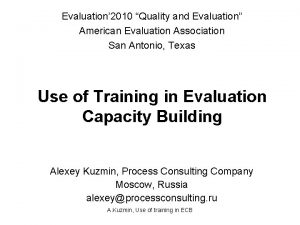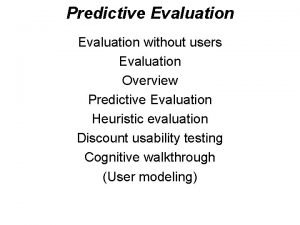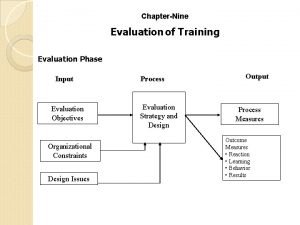ECONOMIC EVALUATION Economic evaluation what is it Economic















- Slides: 15

ECONOMIC EVALUATION

Economic evaluation: what is it? § § § Economic evaluation is the traditional tool for prioritizing road investment It provides a monetarised indicator which can be used as an absolute (good or bad) or relative (better or worse) for prioritising It is unavoidable for road investments where benefits are largely direct, quantifiable and financial (user savings) Very unreliable when benefits are difficult to quantify or measure and are more concerned with wellbeing Techniques can be complex (HDM-4) or simple


Economic evaluation tools § Economic evaluation tools are part of the family this section talks about: others looked at are: Basic access planning § Integrated rural accessibility planning § Classic economic evaluations are centred on user benefits and prefer to sweep wider social questions under the carpet § They are very useful when investors want an simple technocratic investment strategy § But they throw up their hands when confronted with the complicated mix of social and economic objectives of rural roads §


Economic evaluation tools (2) They compare forecasts of user benefits with investment and maintenance costs to obtain a rate of return on investment § Good for prioritisation when direct user savings are large (lots of traffic) and social impacts can be ignored § Progressively applicable for low-volume rural roads when motor traffic 30+/day § Powerful computerised tools available for use on well-used main and secondary roads §

Economic evaluation: how it is done (HDM-4 and RED) § § § Collect data on road user characteristics, traffic types and volumes Collect data on existing road characteristics, geography, climate Collect data on expected improvement and maintenance costs Combine and mix well Use with moderation!

Economic evaluation: what comes out? Optimal maintenance strategy for each road option (do nothing to complete rebuild) § Internal rate of return (IRR) for each optimized investment option for ranking § Investment plan (what to do? When? ) §

Economic evaluation tools: HDM § What it does: Uses sub-models to calculate road wear and resulting costs to users as a function of traffic, climate, topography for different levels of improvement and maintenance § Determines the optimal investment and maintenance programme (when road costs+user costs minimum) § § Comments § Essential when traffic is high (secondary and main roads) and effectiveness can be measured in monetary terms

Economic evaluation tools: RED § § § Useful on simpler roads where motor trafic low relative to other traffic Allows flexible treatment of the analyis and results (easier to play around with it) Takes account of non-motorised traffic Quantifies periods of road closure Calculations not centred on road roughness (IRI) Can be used when motor traffic significant

Economic evaluation: for and against For: § Provide standardised method to compare investments nationally or internationally § Generally obligatory for major projects because coherent and reasonably transparent § Against: § Power of complex models to simulate real life often over -estimated § Reliance on user savings obscures land-use planning and social issues § Results can be easy to manipulate § Favours short run benefits over long run sutainability § Takes for granted that users pass on benefits (lower fares, better service) §

Economic evaluation tools: RONETS

Economic analysis tools: my own § § § I developed this Excel application in Vietnam about ten years ago Applied it in Uganda (twice) and other places It allows almost split-second comparison of upgrading strategies using basic unit costs and an IRR criterion Takes into account all types of users, even walkers Use it to prioritize network links when traffic over about 20 vpd and/or some heavy vehicles

Practical considerations Models need calibration as they often produce nonsense § Use them for comparing rather than providing absolute values § Very sensitive to IRI (road roughness) and not to others § Vehicle operating cost v. roughness equations not valid for very bad roads §

References: economic evaluation Economic evaluation notes § User guide: road management tools § Simple Cost-Benefit Analysis for lowvolume roads §
 Economic growth and development
Economic growth and development Economics unit 1 lesson 2 difficult choices
Economics unit 1 lesson 2 difficult choices Economic growth vs economic development
Economic growth vs economic development Adpie acronym
Adpie acronym Student peer evaluation examples
Student peer evaluation examples Non discriminatory evaluation
Non discriminatory evaluation Evaluation
Evaluation Strategy evaluation assessment matrix
Strategy evaluation assessment matrix Heuristic evaluation function
Heuristic evaluation function The main applications of syntax directed translation is
The main applications of syntax directed translation is Project analysis and evaluation
Project analysis and evaluation Simple evaluation questions examples
Simple evaluation questions examples Technical bid evaluation
Technical bid evaluation Decision oriented evaluation approach
Decision oriented evaluation approach Evaluation for unit 6
Evaluation for unit 6 Sensory evaluation of dairy products
Sensory evaluation of dairy products







